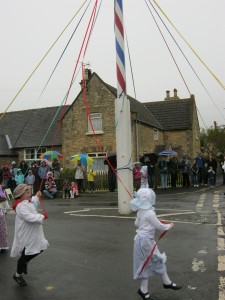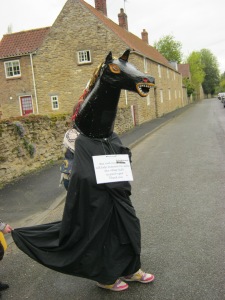Mayor Making, that is the enthronement of a new Mayor, in Rye is an old tradition at least dating back 700 years. There are of course lots of such ceremonies in the country and whilst they are delightfully high in pomp, ceremony and colour, they are not as unique as what happens after Rye’s mayor is made. For afterwards the Mayor party take to the Town hall windows high above the square and rain pennies down upon the crowd.
I attended the Throwing of the Hot Pennies as part of my mad May day weekend dash – having already experienced Oxford May Morning, Lewes May Garlands and stopped here on my way to the Rochester May Day and finishing off the day with the Hammersmith Jack. It was a bit of mad rush and adventure!
Why did Rye do this and not other places? Penny throwing or scrambling is found in other places such as Driffield and Reach Fair but these were often done for commercial reasons to encourage local children to spend money. This may be the reason but why would Rye do this and not other towns?
Hot money!
Jacqueline Simpson (1973) Folklore of Sussex states that one of the main reasons was that this was because Rye had its own mint and one day she states:
“The town ran out of pennies on Mayor’s Day, and a boy sent to fetch new ones from the mint brought them back so fast that they were still hot.”
The other would be that once the Mayor of Rye was a member of parliament and so provided money to bribe the voters. To be honest neither really make sense! Tony Foxworthy in his Customs in Sussex adds further reasons:
“The reason the pennies are heated before being thrown is to make sure the bigger children dont get larger handfuls than the smaller children (very likely)
The simple reason for throwing heated coins is to instil on the young people of Rye’s mind the importance of the day when the Mayor of Rye is installed.”
Although again this does ask why Rye?
Coined a profit!
It was reported in 1967 that the local bank had supplied coins that were minted in 1951 which was extraordinary as in this year most of the coins minted were sent to British dependencies in the West Indies and so made them rare. It was reported that after throwing £2.10s worth of coinage it was worked out that each penny was actually worth £12 and as such the rest of the coins were valued and kept safe…cannot imagine this rather put a dampener on all the fun!
In those days the total thrown was £5 now it is £20 and at some times in the past the George Hotel was used.
Scramble to get there!
I turned up just in time to see a large crowd of excitable children mass below the Town Hall and the new Mayor turn up flanked by two mace bearers. A sort of hush descend as the windows opened and the crowd looked up in anticipation. A gleeful Mayor with a shovel in his hand tossed it upwards and off the coins went flying into the air! Soon all the children fell to the floor desperate to pick as many as possible. There was clearly a lot of enjoyment and the children would certainly remember it in many years to come….clearly the reason they did it!
PLEASE NOTE THIS BLOG WAS IN A BIT OF OBEYANCE OVER THE LAST YEAR BUT AS A NEW YEAR’S RESOLUTION I AM DETERMINED TO COMPLETE ALL MONTHS BEFORE THE END OF JANUARY…THE BLOGS 10TH ANNIVERSARY!





